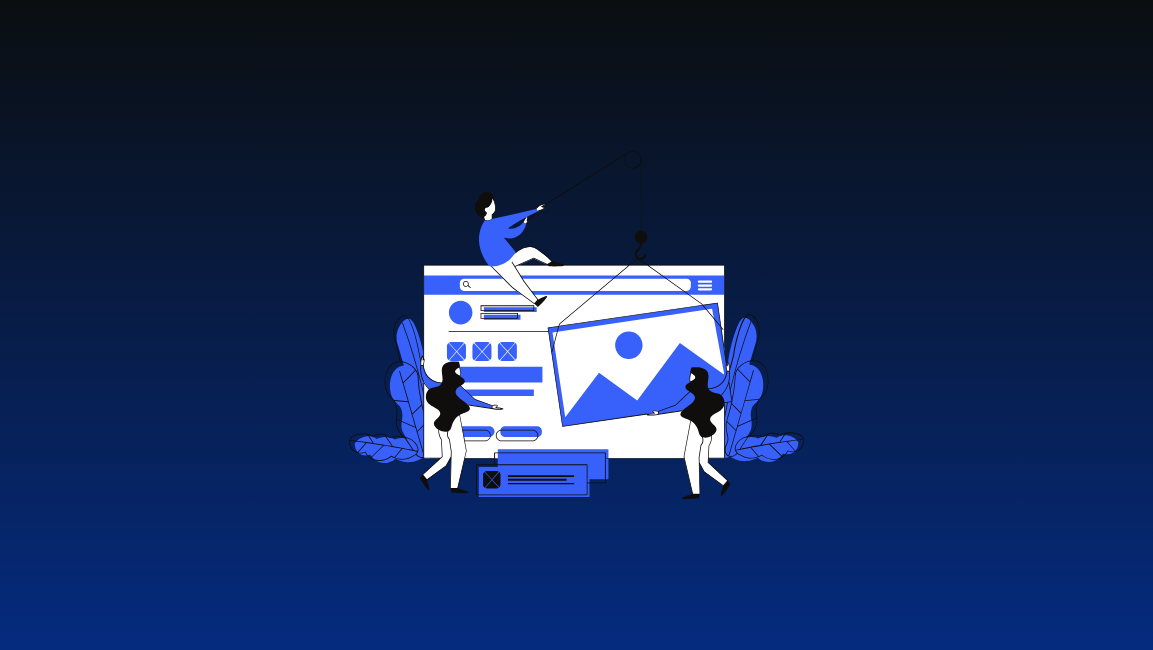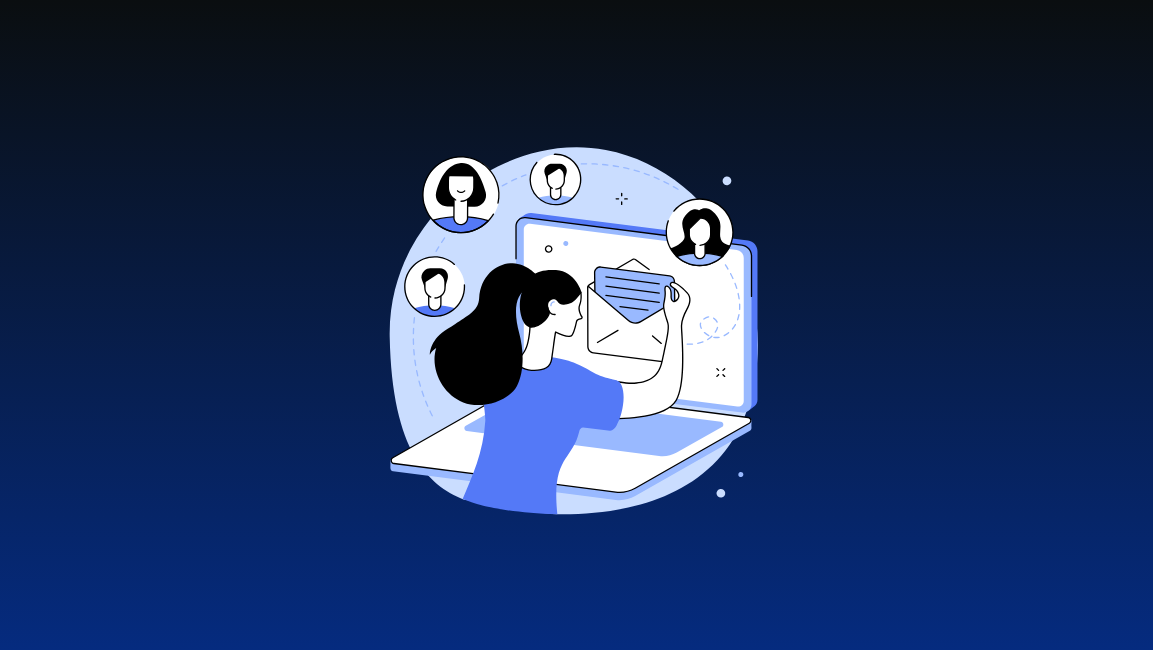When was the last time you bought a product, and told someone about it? If you’re in the 55% majority of consumers who share purchases socially, it probably wasn’t too long ago.
Word-of-mouth recommendations are a natural byproduct of social interactions–talking about new restaurants found, new travel locations visited, and yes, new products bought by happy customers.
Now, with social media, the ability to share goes beyond 1:1 interactions and has turned into sharing recommendations to followers across TikTok, Instagram, Twitter, Pinterest, or Facebook.
Successful brands who saw this trend emerge have created a way to capture existing word-of-mouth and incentivize more. By throwing fuel on a fire already burning, they’re able to acquire new customers faster and at a lower cost.
How? Through a customer referral program.
In this article, we’ll share exactly what a referral program is, how you can create a successful referral program, and ways that actually incentivize customers to refer.
Ready? Let’s do this.
What is a referral program?
A referral program is a structured system that uses referral incentives to encourage past customers to recommend a product or service to others in their network. The referral process is tracked using discount codes, coupons, or unique referral links. Referral programs are a key piece to marketing strategy. And, it works. More than 50% of people are likely to give a referral if offered a direct incentive.
A referral program can also be known as a refer-a-friend program. However, referral programs don’t just apply to individual customers. Retailers often work with influencers to refer their audiences in exchange for a referral reward.
One simple example is Dropbox, the cloud storage software, offers 500mb of free storage space by referring someone to create a Dropbox account. Or, a well known example is Tesla, who allow referrers to earn credit for Tesla products or services.
This is different from a traditional rewards program that offers points or loyalty tiers in exchange for a purchase made by customers.
Want to build a referral program for your Shopify store? Try Social Snowball FREE!
What is the difference between a referral program and a referral marketing campaign?
Just like an individual ad run online is different from an advertising campaign, a referral program can be independent from a referral campaign. For example, maybe a brand wants to run a referral marketing campaign to acquire more customers around Black Friday. In order to acquire more customers, they create a special Black Friday referral program that incentivizes referrals with 40% off to referees. This is a referral marketing campaign that is limited to Black Friday, using a referral program that offers 40% off.
Many brands have consistent referral programs that run in the background and encourage customers who purchase to refer a friend in return for a discount or incentive. Similar to how many brands consistently give 10% off in return for email subscriptions on top of other marketing campaigns.
What is the best way to incentivize referrals?
The best way to incentivize referrals is to find what incentives actually activate your loyal customer base. Many brands default to a discount percentage off, and find their program isn’t as effective as they want it to be.
The truth is, different incentives will work for different brands. The best way to incentivize your referral marketing program is to figure out which type of incentive is best for your customers and will drive the best results.
What are the different types of referrals or incentives?
Cash Rewards
A cash reward is a clear incentive to customers. If you refer someone, you receive cash in return–A win-win. This means the referrer can receive the cash straight to their bank balance or PayPal and use it as they please. For many customers, this is the most enticing incentive without limitations.
One example in action is Outway’s affiliate program, which sees a 5x ROI and acquires over 500 new customers per month–driving over 9% of their gross merchandise volume. They give 15% off to those referred, and give $15 to the referrer when a purchase is made.

Discounts
Discounts are an incentive that not only encourage someone to refer, but also encourage them to make a repeat purchase themselves. Since they have to make an additional purchase to take advantage of the incentive, it’s harder to activate customers than giving them free products or cash. However, for the right customer audience this can be an incredibly effective incentive.
One example is Latico Leathers’ referral program, which offers 15% to the referrer every time a purchase is made by someone they’ve referred. With a high repeat purchase rate among their customer base already, offering a discount code to incentivize referrals made the most sense when structuring their program. They saw great results, with a 17.3x return on investment and increased referral revenue by over $18,000.

Store Credit and Gift Cards
Similar to discount codes, offering store credit and gift cards is a great way to encourage repeat purchases. The difference to discount codes is that you can offer store credit or gift cards that are enough to cover a free product or sample. This will help increase repeat purchases and average order value. Store credit or gift cards can be for your own store.
However, you can also offer gift cards to other vendors. If you’ve ever purchased a technology product, SaaS companies are notorious for offering gift cards in return for a product demo. One example is receiving an Amazon gift card in return for a booked meeting.
What are the benefits to a referral program?
- Attracts new customers at a low cost to acquire. Contrary to paid ads, a referral program leverages your existing customer base by activating them as referrers. This is a low cost way to encourage sharing your brand and drive customer acquisition. Creating a referral program in addition to other paid performance campaigns can help lower your blended cost to acquire, as it did for Outway Socks. Plus, each new referral snowballs– A referred customer is actually 4x more likely to refer another customer to the brand.
- The customers acquired are more loyal. Not only are more customers acquired at a lower cost, but the customers you acquire through referrals are much more valuable than through other marketing channels. In fact, Wharton says the customer lifetime value of a referred customer is 25% higher than a regular customer. By incentivizing referrals, you can actually see customer loyalty increase.
- Attribution of word-of-mouth marketing. Word-of-mouth marketing already exists among your customers, but your own referral program is a great way to track how much advocacy there actually is using links and discount codes. A structured program helps you track, attribute, and fuel more referrals. For each cohort of new customers, you can compare the customer retention of those referred versus non-referred.
- Helps you identify and reward your most best customer advocates. Since you can track what referrals are happening, you’re able to see which customers are the biggest advocates for your brand. If there are a select few customers referring a lot of business to your brand, you can send them personalized gifts, incentives, or communications to let them know you appreciate them. For large influencers, you can run more in-depth referral marketing campaigns like giveaways or provide upgrades to their incentives.
How does a referral program work?
A referral program works by using a software to create incentives, track the referrers and referral links shared.
Before we show you how to create a referral program, there are a few components to how the program works behind the scenes.
- Referral program structure and process. Your program has to have a structure for what incentive is offered, how it is tracked, and how it is redeemed. Including emails that notify someone when they’ve joined the program, when they’ve referred, and give them all the information they need to be in your referral program.
- Referral program management. When someone is added to your referral program, a discount code or link is created, and they begin to share it, you need a way to manage who is in your referral program and how the program stays automated and organized. This includes managing and protecting against referral fraud.
- Payouts and reward redemption. Those who refer or are referred have to have a way to redeem the incentives that you’re offering. Using a referral marketing software, you can automatically allow those who refer to receive benefits or payouts.
How do you come up with a referral program?
In digital marketing, it’s common practice to use discount codes or promotions in order to run marketing campaigns. A referral program is a great way to level-up customer experience.
Coming up with your referral program can be as simple as starting a basic program and seeing how your customer base responds. As you test different amounts or methods of incentivizing, you can find the best program for your customers. We’ve created a simple outline for how you can begin to create your referral program.
How to create a referral program
Set goals for your program
For any marketing campaign, outlining your goal is critical. So, what’s your main goal for creating a referral program?
Some common metrics brands look to increase with a referral program are revenue, average order value, new customers acquired, conversion rate, and the cost to acquire those customers. You should then tailor the program you create and incentives you offer to align with your goal.
Find how existing referrals are happening for your brand
A great place to start with your referral program is to find out how you’re getting referrals now. Is it from existing customers? Do you have a network of influencers who promote your products without you knowing online?
Arming existing advocates with a compelling incentive is the quickest way to find the right program for your brand.
Decide on the right incentive
Depending on what you already offer customers, like regular sales or offers for subscribing to your marketing, finding a compelling incentive for a referral is the different between an average referral program and one that drives significant revenue.
Earlier in the article, we outlined 3 ways for you to incentivize your customers with cash, discount codes, or store credit and gift cards.
Make your program easy to join
The more accessible your program is for customers or influencers to join, the more likely your program is to go. Finding ways for your customer base to continually join your referral program, as well as potential customers to discover it will give you the best result.
After someone makes a first purchase, automatically enrolling them in a default referral program to encourage sharing post-purchase. A great way to do this is to place a referral link or discount code on the thank-you page.
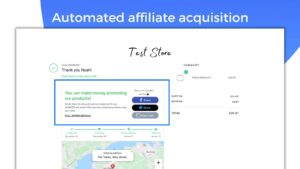
For more formal programs, especially ones that include influencers who promote to their subscribers, it is best practice to create a landing page that showcase the benefits to your referral program and allow someone to sign up.
Launch your referral program
The most successful referral programs launch in two parts. First, launch your referral program to your current customers, and second, find ways to add new customers to your referral program.
For current customers, launching your program via email and creating a sign-up page to collect their information is an easy way to grow your program. If you want to really incentivize them, you can create a special promotion for early program entrants who refer. For example, extra incentives or perks.
For newly acquired customers, adding them automatically to the referral program automatically post-purchase is the easiest way to activate them. Using email templates, you can share a unique referral code or discount code with a new customer and let them know about the benefits of your referral program.
What is a good referral program software?
Referral marketing software helps a retailer create referral programs, and automate the on-going management of them.
If you have hundreds or thousands of customers joining your program and each has a unique link or discount code created…. that turns into a mess really fast! Ongoing management of your program and any changes you’d like to implement should be easy to manage.
The best softwares will help you stay organized to reward customers, create multiple programs with different incentives. Social Snowball is used by 1,000+ ecommerce brands like Outway Socks and Latico Leathers to create a referral program, manage the referral process, stay organized, and drive more revenue. Social Snowball offers a 30-day free trial so you can create a successful referral program–as well as affiliate programs and influencer programs.
“Affiliate and referral is a channel we hadn’t put much effort into really because we couldn’t find a good solution and weren’t satisfied with the other apps out there. That’s why I tweeted looking for recommendations, and Social Snowball was the only one recommended in the replies.” -Rob Fraser, Founder of Outway Socks
Customer referral program ideas
The best ideas for a customer referral program will come from looking at examples of other programs that already exist. Depending on your vertical, the best practice may vary. For example, if you’re a high average order value furniture brand, the program you may want to create will be different than a lower average order value beverage brand. Taking a look at the brands in your vertical is a great way to gather ideas.
We’ve also compiled a list of referral program examples that can help inspire you while you create your program. For the full list of 16 programs, take a look at this recommended article.
6 referral program examples to inspire your referral program
1. Dollar Shave Club

Dollar Shave Club is an iconic & inspirational ecommerce business example, especially for stores that sell subscriptions.
You probably know Dollar Shave Club for the viral video that surfaced during the initial days. What you might not know is that the video is not the only reason for their strong word-of-mouth marketing. According to their founder’s interview, 50,000 people a month refer a friend to Dollar Shave Club. This didn’t happen by fluke.
Dollar Shave Club strategically creates a delightful customer experience with their product and encourages users to join their referral program in exchange for up to $15 DSC store credit. They dedicate 50% of their email outreach to referrals and ask customers to refer their friends. Since customers are on a monthly subscription, a $15 store credit is a strong incentive to save money on their next order.

2. Leesa

Most people buy mattresses once in 8 to 10 years and seek advice from friends and family before making a purchase. Leesa, an eCommerce mattress brand, runs a rewarding customer referral program to benefit from this buying behavior.
They offer $75 to their customers via PayPal (after referral finishes their trial period) and a 100-night sleep trial to their friends – making it extremely easy for customers to convince their friends to purchase from Leesa.
The referral program became so successful that Leesa witnessed 3,000 customers joining the referral program, driving 33% of the total sales.
3. ASOS
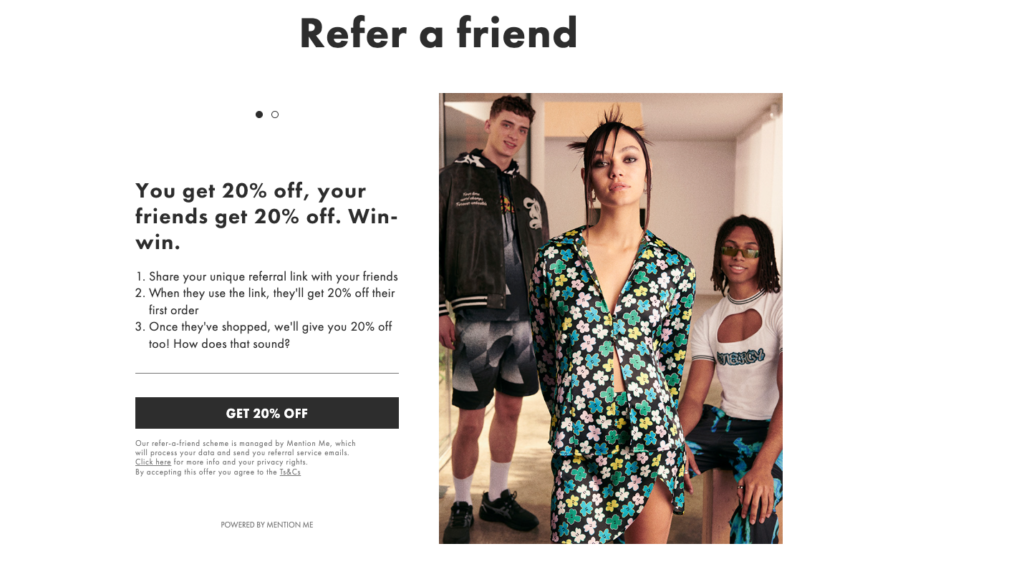
ASOS is a well-known fashion brand known for its modern marketing campaigns and engaging social media presence. They have a cult following of customers who miss no opportunity to buy from them, especially when there are discounts.
Encashing this opportunity, ASOS runs a two-sided referral program that gives 20% off to the referrer (existing customer) and 20% to the referee (new customer).
4. Dia & Co

Dia & Co is creating a safe space for plus-size women to buy the trendiest clothes in the market. As a part of their customer acquisition strategy, they’ve created a two-sided referral program for their customers. They reward existing customers $25 for referring friends, and referred customers receive a $25 discount + domino rewards on their future purchases.
Dia & Co used email marketing as their key marketing channel to prompt existing customers into joining their referral program. As a result, Dia & Co saw 40,000 customers share referral links, bringing 22 conversions a day during the first month itself.

5. Dr. Squatch
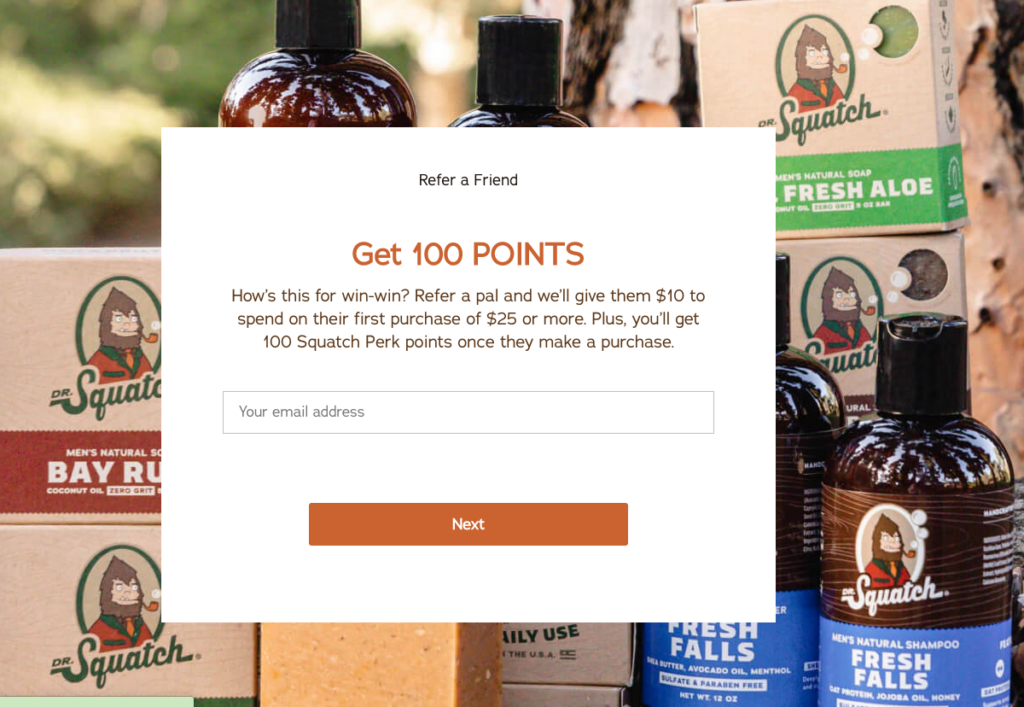
Dr. Squatch is a men’s soap brand. They built a referral program, and A/B tested it to determine the right offer strategy for their program. They created a double-sided referral offer and added two benefits to A/B test the offers: a $10 credit or a free soap bar. They concluded that customers found offers better than $10 credit.
Using insights from their A/B test, they created their current referral program that provides 100 points to customers & $10 discount to their referred customers. Customers can redeem their points to get direct discounts on their next purchase.
6. Rothy’s
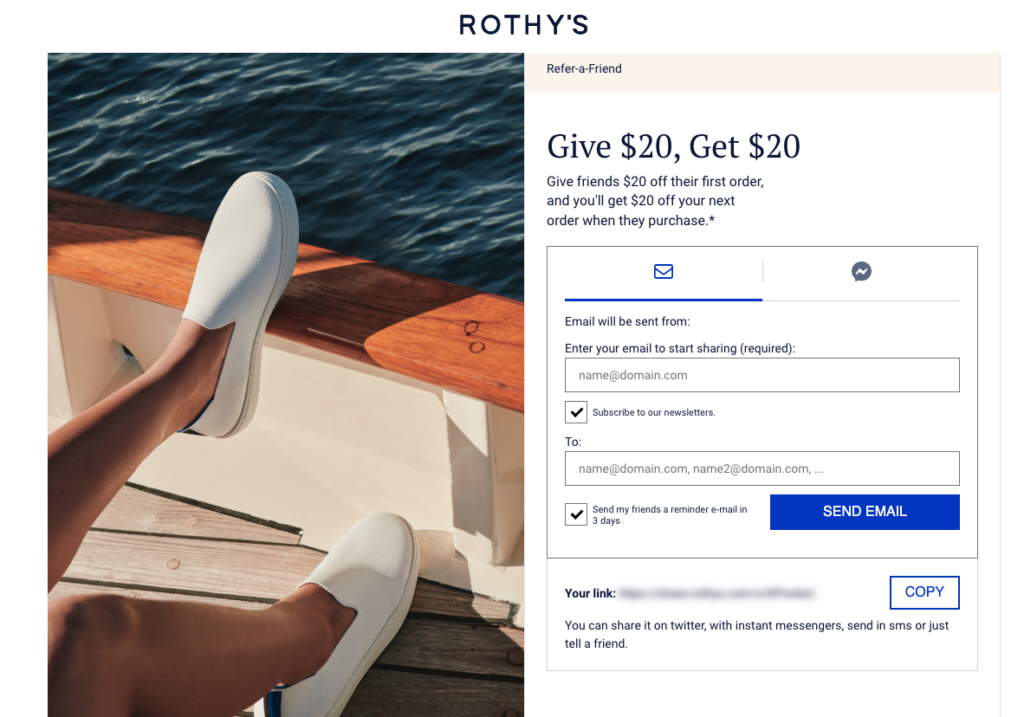
Rothy’s makes stylish flats, shoes, and handbags from 100% recycled plastic, and customers love them for it. The brand enjoys so much attention that word-of-mouth outweighs most of its marketing channels in getting customers.
They have a Facebook group with 23000+ customers bringing a lot of attention to the brand.
Rothy’s nurtures this community with a referral program that directly caters to the collective interest of their customers/followers – to grow the brand and increase its customer base. They offer a $20 direct discount to their customers and the friends they refer to buy from them.
What is the best referral program?
A question often asked by brands, but the answer isn’t straight forward. The truth is that the best referral program is the one that activates the most referrals from existing customers and newly acquired customers. Using a referral program software to create your program and find what incentive best activates your customers will be the best referral program for you.
Inspired and Ready to Go? Build Your Referral Program!
Now, it’s your turn! By setting the right goals, and and creating your referral program using this guide, you’ll be able to set-up a successful revenue driving program that acquires new customers–Just like Outway Socks.
Want to build a referral program for your Shopify store? Try Social Snowball FREE!

